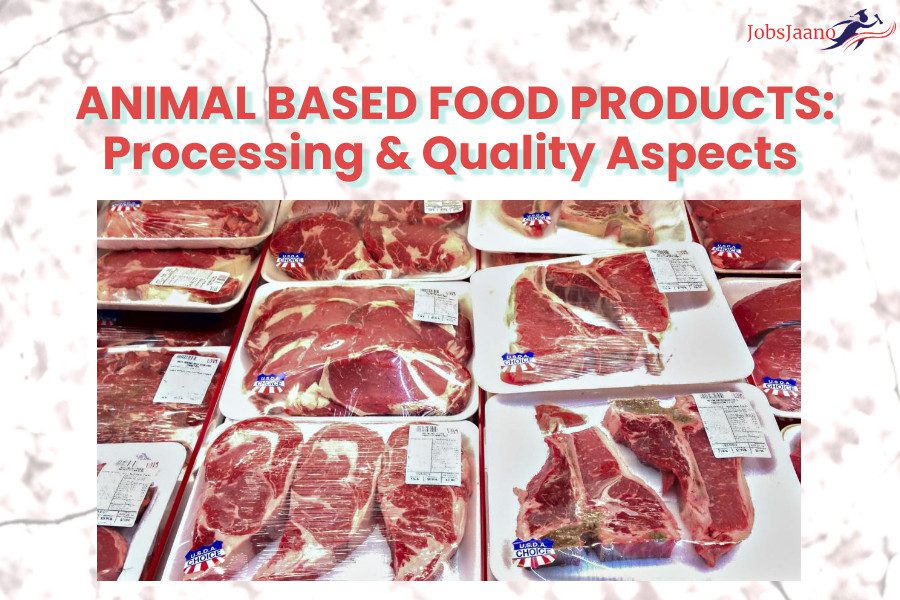Multiple Choice Questions on Sources of Food
1. Blue cheese is also called as:
a. Roquefort cheese
b. Cottage cheese
c. Camember cheese
d. Soft cheese
Ans. a
2. Lactometer can be used to:
a. Find adulteration of milk by water
b. Find the specific gravity of milk
c. Both a and b
d. None
Ans. c
3. As per FSSAI, minimum SNF content of buffalo milk is:
a. 5%
b. 7%
c. 9%
d. 13%
Ans. c
4. As per FSSAI, minimum amount of fat in toned milk should be:
a. 3%
b. 7%
c. 9%
d. 13%
Ans. a
5. The product remaining after the removal of most of the casein and fat from milk process of cheese making:
a. Whey butter
b. Whey cheese
c. Whey
d. Condensed whey
Ans. c
6. Milk fat is:
a. Oil-in-water type emulsion
b. Water-in-oil type emulsion
c. Colloidal state
d. None
Ans. a
7. Which of the following test is used to detect sesame oil in milk?
a. Halphen test
b. Baudouin test
c. Kreis test
d. Polenske value
Ans. b
8. The coagulation of milk proteins by heat consists of :
a. Denaturation
b. Agglutination
c. Denaturation and agglutination
d. None
Ans. c
9. Phosphatase test is not applicable for:
a. Pasteurized milk
b. Sterilized milk
c. Both a and b
d. None
Ans. b
10. Which of the following is a lactic acid alcohol fermented milk, originated in Russia?
a. Kumiss
b. Kefir
c. Yoghurt
d. Bulgarian Buttermilk
Ans.. a
Multiple Choice Questions on Meat
11. While manufacturing the toned milk:
a. Both the aft and solid -not-fat are reduced
b. Fat content is reduced and solid-not-fat is increased
c. Fat content is increased and solid-not-fat is reduced
d. None
Ans. d
12. Churning is a process of phase reversal in which:
a. Water-in-oil type emulsion is changed to oil-in-water type emulsion
b. Oil-in-water type emulsion is changed to water-in-oil type emlsion
c. Oil-in-water type emulsion is changed to colloidal suspension
d. None
Ans. b
13. Sugar as constituent of ice cream has following limitation:
a. High calorific value
b. Lowers whipping ability
c. Excess body and melting resistance
d. None
Ans. b
14. The only carbohydrates present in the milk is:
a. Maltose
b. Sucrose
c. Glucose
d. None
Ans. d
15. Cheese is classified on the basis of:
a. The fat content
b. The moisture content
c. Both a and b
d. The protein content
Ans. b
16. The father of White Revolution is:
a. Dr. M. S. Kurien
b. Dr. V. Kurien
c. Dr. S. Kurien
d. Dr. A. Kurien
Ans. b
17. As per the FSSAI, minimum fat % in double toned milk is:
a. 0.5
b. 1.5
cc. .5
d. 3.5
Ans. b
18. Marinades are prepared from:
a. Egg
b. Meat
c. Fish
d. Cereals
Ans. c
19. Nitrate and nitrite are helpful in meat processing as it:
a. Increases tenderness
b. Increases juiciness
c. Improves color
d. Prevents from microbial deterioration
Ans. c
20. Nitrate and Nitrite along with Sodium Chloride is called as:
a. Cruing agent
b. Emulsifier
c. Anticaking agent
d. Fumigating agent
Ans. a
Which of the following is a technique applied to the processing of fresh meat
21. Veal is obtained from:
a. Sheep
b. Buffalo
c. Goat
d. Calf
Ans. d
22. Condition of toughening of the muscle of the meal after slaughtering of animals is called:
a. Rigor toughening
b. Rigor mortis
c. Rigor hardening
d. Rigor tightening
Ans. b
23. The chief muscle pigment is:
a. Myoglobin
b. Myoerythrim
c. Myocyanin
d. Myocholine
Ans. a
24. Smoking in used for the preservation of:
a. Cereals
b. Meat
c. Egg
d. Fruits
Ans. b
25. Deposition of fat within the lean muscle is called:
a. Curing
b. Marbling
c. Homogenization
d. None
Ans. b

26. Tenderization of meat leads to the:
a. Softening of muscles
b. Retaining the color of meat
c. Prevention of microbial deterioration
d. All of the above
Ans. a
27. Pork is never aged because:
a. It is not consumed largely
b. Ageing of pork is not likely by consumers
c. It has high fat content
d. None
Ans. c
28. The tenderness of meat is determined by:
a. The amount and distribution of connective tissues
b. The size of both muscle fibres and bundles of fibres
c. Moisture content of muscle
d. Both a and b
Ans. c
29. Meat is tenderized by:
a. Using proteolytic enzymes
b. Using low levels of salts
c. Changing the pH of meat
d. All of the above
Ans. d
30. The proteolytic enzymes used in tenderizaion of meat are:
a. Papain
b. Bromelin
c. Ficin
d. All of the above
Ans. d
Meat Quiz Questions and Answers
31. A component of the egg which is responsible for holding the yolk in the centre of egg is:
a. Air cell
b. Chalazae
c. Shey
d. Vitelline membrane
Ans. b
32. Which of the following statement is correct?
a. As the egg becomes older, white of the egg becomes thinner and yolk membrane becomes weaker
b. As the egg becomes older, white of the egg becomes thicker and yolk membrane becomes weaker
c. Both a and b
d. None
Ans. a
33. The thin surface layer of proteinaceous material acts as protective layer in egg is:
a. Cuticle
b. Chalazae
c. Vitelline membrane
d. Shell membranes
Ans. a
34. Enzymatic meat tenderization methods are:
a. Injection of an enzyme into the animal before slaughter
b. Introducing enzyme through fork holes into meat after cooking
c. Dipping the meat pieces in enzyme solution
d. Freeze drying the meat and rehydrating with the water containing enzyme
Ans. a
35. A complete destruction of microorganism is achieved by:
a. Pasteurization
b. Blanching
c. Sterilization
d. Homogenization
Ans. c
36. Whey is separated from milk by:
a. Osmosis process
b. Centrifugal separation
c. Sedimentation proccess
d. Membrane separation
Ans. d
37. Heat exchangers are used to……… the product:
a. Heat
b. Cool
c. Heat or cool
d. Maintain constant temperature
Ans. c
38. Homogenization reduces the mean diameter of fat globules by a factor of:
a. 10
b. 100
c. 1000
d. 10000
Ans. a
39. During pasteurization ……….. will be destroyed:
a. All M.Os
b. Only Bacteria
c. Enzymes inactivated and pathogenic bacteria
d. Only pathogenic bacteria
Ans. c
40. Water content of skimmed milk is:
a. 60
b. 80
c. 70
d. 90
Ans. d
Multiple Choice Questions on Poultry
41. The product derived out of milk after removal of water is:
a. Skimmed milk
b. Butter milk
c. Whey
d. Curd
Ans. c
42. In HTST system milk is heated to 132 degree C for:
a. 6 sec
b. 60 sec
c. 6 min
d. 60 min
Ans. a
43. Milk sugar is:
a. Lactose
b. Glucose
c. Sucrose
d. Maltose
Ans. a
44. The yellow color of cow milk is due to the presence of :
a. Vitamin B
b. Carotene
c. Anthocyanin
d. Xanthophyll
Ans. b
45. Cow milk’s protein is:
a. Albumin
b. Zein
c. Casein
d. Lactoalbumin
Ans.. c
46. Temperature and time of LTLT pasteurization is:
a. 45-49 degree C (28min)
b. 51-59 degree C (25min)
c. 59-60 degree C (35min)
d. 61-63 degree C (30min)
Ans. d
Poultry Production Objective Questions
47. Element deficient in milk is:
a. Fe
b. Mg
c. P
d. Ca
Ans. a
48. National Dairy Research Institute is located at:
a. Delhi
b. Izatnagar
c. Jhansi
d. Karnal
Ans. d
49. Casein is …… % of total milk protein:
a. 80-83
b. 70-71
c. 60-65
d. 42-45
Ans. a
50. Operation flood is related to:
a. Milk
b. Rice
c. Potato
d. Pulses
Ans. a
51. Specific gravity of milk is:
a. 1.03
b. 1.05
c. 0.85
d. 0.93
Ans. d
Animal Based Food Products mcqs pdf
52. Oil content of shelled groundnut is…… %
a. 40-45
b. 45-50
c. 50-55
d. 55-60
Ans. a
53. A separator used to separate grains, based on thin surface texture and stickiness properties of grain is known as:
a. Magnetic separator
b. Spiral separator
c. Cyclone separator
d. Pneumatic separator
Ans. d
54. Oil content in parboiled rice bran is …… raw rice bran :
a. Very less than
b. Less than
c. Same as
d. More than
Ans. d
55. Oil content of coconut (copra) is approximately:
a. 36-45%
b. 46-55%
c. 56-65%
d. 66-70%
Ans. c
56. In pulse milling process, mixing with red earth is known as:
a. Dry milling
b. Wet milling
c. Hardening
d. Pitting
Ans. b
57. Hot pulses are tempered after each pass in tempering bin for about …. hours:
a. 4
b. 6
c. 8
d. 10
Ans. a
58. Maize oil and gluten has the following percent of protein:
a. 50
b. 55
c. 60
d. 65
Ans. a
59. The major carbohydrate present in rich is:
a. Glucose
b. Fructose
c. Starch
d. Pectin
Ans. c
60. Which of the following is a technique applied to the processing of fresh meat?
a. Chopping
b. Protein Extraction
c. None
d. Chopping & Protein Extraction
Ans. a
61. Coated meat products require:
a. Breading
b. Pre-dusting
c. Battering
d. All three methods of making coated meat products
Ans. d
Animal Based Food Products mcqs with answers
62. Certain bacteria are added to minced meat products. This activity is followed by dehydration. What is this activity called?
a. Coating
b. Freezing
c. Curing
d. Fermentation
Ans. d
63. Which of the following is responsible for a musty or earthy flavour?
a. Actinomcetes
b. Flavobacteriu
c. Both a and b
d. Pseudomonas syncanea
Ans. c
64. Molds causing spoilage of eggs include species of
a. Cladosporium
b. Mucor
c. Thamnidium
d. All of these
Ans.. b
Animal Based Food Products mcqs
65. Vacuum packaged meats are spoiled by
a. B.thermosphacta
b. Lactobacilli
c. Both a and b
d. None
Ans. d


